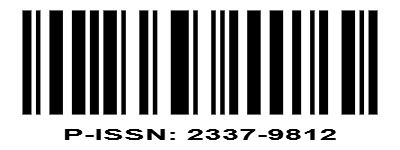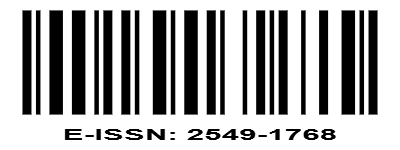Effect of Fungicidal Methanol Extract of Kirinyuh Leaves (Eupatorium odoratum L.) and Noni Leaves (Morinda citrifolia L.) against MOLD Fusarium oxysporum on Tomatoes
DOI:
https://doi.org/10.22373/biotik.v12i2.25335Keywords:
fungicide, kirinyuh, noni, tomatoes, Fusarium oxysporum.Abstract
Tomato plants are one of the leading horticultural commodities that are easily attacked by disease. Plant wilt disease is one of the diseases that often attacks tomato plants which is caused by Fusarium oxysporum. The use of chemical fungicides causes many losses, so there is a need for plant-based fungicides made from natural ingredients. Kirinyuh leaves and Noni leaves are natural ingredients that can be used as a vegetable fungicide to control fungi Fusarium oxysporum. The experiment was carried out alive and prepared using a Completely Randomized Design with 6 treatments and 6 replications. Data obtained from observations will be analyzed using the Duncan test at the 5% level. The concentrations used by each extract were 20%, 40%, 60%, and 80%, negative control (Aquadest), positive control (dithane M-45). The results showed that the Noni leaf extract fungicide with a concentration of 60% had the most effective effect in inhibiting the fungal growth zone Fusarium oxysporum on tomatoes.
Downloads
References
S. Fajri, H. Gunawan, L. R. Batubara, and Z. Sitorus, “Prediksi Hasil Produksi Tanaman Tomat di Indonesia Menurut Provinsi Menggunakan Algoritma Fletcher-Reeves,” Build. Informatics, Technol. Sci., vol. 4, no. 3, pp. 1471–1482, 2022, doi: 10.47065/bits.v4i3.2704.
Heriyanto, “Kajian Pengendalian Penyakit Layu Fusarium dengan Trichoderma pada Tanaman Tomat,” J. Trit., vol. 10, no. 1, pp. 45–58, 2019.
R. R. Djamaluddin, E. Sukmawaty, M. Masriany, and H. Hafsan, “Identifikasi Gelaja Penyakit dan Cendawan Patogen Tanaman Bawang Merah (Allium ascolonicum) di Kecamatan Buntu Batu Kabupaten Enrekang,” Teknosains Media Inf. Sains dan Teknol., vol. 16, no. 1, pp. 81–92, 2022, doi: 10.24252/teknosains.v16i1.26027.
M. Dita, M. Barquero, D. Heck, E. S. G. Mizubuti, and C. P. Staver, “Fusarium Wilt of Banana: Current Knowledge on Epidemiology and Research Needs Toward Sustainable Disease Management,” Front. Plant Sci., vol. 9, no. 1468, pp. 1–21, 2018, doi: 10.3389/fpls.2018.01468.
O. R. Aji and Y. Rohmawati, “Antifungal Activity of Morinda citrifolia Leaf Extracts Against Fusarium oxysporum,” Indones. J. Biotechnol. Biodivers., vol. 4, no. 1, pp. 20–26, 2020, doi: 10.47007/ijobb.v4i1.51.
W. Sari, S. Wiyono, A. Nurmansyah, A. Munif, and R. Poerwanto, “Keanekaragaman dan Patogenisitas Fusarium spp. Asal Beberapa Kultivar Pisang,” J. Fitopatol. Indones., vol. 13, no. 6, pp. 216–228, 2017, doi: 10.14692/jfi.13.6.216.
S. Harahap, D. P. Yanti, and S. B. Pardomuan, “Sosialisasi Penerapan Pestisida Nabati Ekstrak Daun Siri-siri (Piper aduncum L.) dalam Mengendalikan Penyakit Karat Daun (Pucciniaarachidis) pada Kacamh Tanah (Arachishypogaea L.) di Losung Batu,” Jurna Nauli, vol. 1, no. 2, pp. 17–22, 2022, [Online]. Available: https://jurnal.ugn.ac.id/index.php/jurnalnauli
O. Bonventure, W. S. O, and G. Odhiambo, “Fungitoxic Properties of Four Crude Plant Extracts on Fusarium oxysporum Schl. F. sp Phaseoli,” African J. Food, Agric. Nutr. Dev., vol. 9, no. 8, pp. 1652–1666, 2009, doi: 10.4314/ajfand.v9i8.48404.
P. A. R. Listiani and P. I. I. Indraswari, “Formulasi, Evaluasi Mutu Fisik, dan Uji Aktivitas Antijamur (Chromolaena odorata (L.) R. M. King & H. Rob.),” Pharm. J. Farm. Indones., vol. 18, no. 02, pp. 324–333, 2021.
V. Utami and M. Catri, “Uji Efektivitas Ekstrak Daun Morinda citrifolia L. Terhadap Koloni Fusarium oxysporum Secara In Vitro,” Pros. SEMNAS BIO, vol. 1, no. 1, pp. 1701–1707, 2021.
D. Frastika, R. Pitopang, and I. N. Suwastika, “Uji Efektivitas Ekstrak Daun Kirinyuh (Chromolaena Odorata (L.) R. M. King Dan H. Rob) Sebagai Herbisida Alami Terhadap Perkecambahan Biji Kacang Hijau (Vigna Radiata (L.) R.Wilczek) Dan Biji Karuilei (Mimosa Invisa Mart. ex Colla),” Nat. Sci. J. Sci. Technol., vol. 6, no. 3, pp. 225–238, 2017.
E. S. Gultom, M. Sakinah, and U. Hasanah, “Eksplorasi Senyawa Metabolit Sekunder Daun Kirinyuh (Chromolaena odorata) dengan GC-MS,” J. Biosains, vol. 6, no. 1, pp. 23–26, 2020.
Jalianto, S. Khotimah, and W. Raharjo, “Uji Aktivitas Antijamur Ekstrak Etanol Biji Buah Langsat (Lansium domesticum Corr.) Terhadap Jamur Candida albicans secara In Vitro,” Fak. Kedokt. Univ. Tanjungpura Pontianak, vol. 1, no. 1, pp. 1–16, 2015.
A. M. S. Putri, “Efek Antifungi Ekstrak Daun Kenikir (Cosmos caudatus Kunth.) terhadap Pertumbuhan Candida albicans secara In Vitro,” 2015.
S. Chismirina, S. Rezeki, and Z. Rusiwan, “Konsentrasi Hambat dan Bunuh Minimum Ekstrak Buah Jamblang (Syzygium Cumini) Terhadap Pertumbuhan Candida albicans,” Cakradonya Dent. J., vol. 6, no. 1, pp. 619–677, 2014.
Downloads
Published
Issue
Section
License
Copyright (c) 2024 Walidatul 'Ulya, Evie Nur Sofhiya, Etika Dyah Puspitasari

This work is licensed under a Creative Commons Attribution-ShareAlike 4.0 International License.
Authors who publish with BIOTIK: Jurnal Ilmiah Biologi Teknologi dan Kependidikan agree to the following terms:
- Authors retain copyright and grant the journal right of first publication with the work simultaneously licensed under a Creative Commons Attribution License that allows others to share the work with an acknowledgement of the work's authorship and initial publication in this journal.
- Authors are able to enter into separate, additional contractual arrangements for the non-exclusive distribution of the journal's published version of the work (e.g., post it to an institutional repository or publish it in a book), with an acknowledgement of its initial publication in this journal.
- Authors are permitted and encouraged to post their work online (e.g., in institutional repositories or on their website) prior to and during the submission process, as it can lead to productive exchanges, as well as earlier and greater citation of published work.











